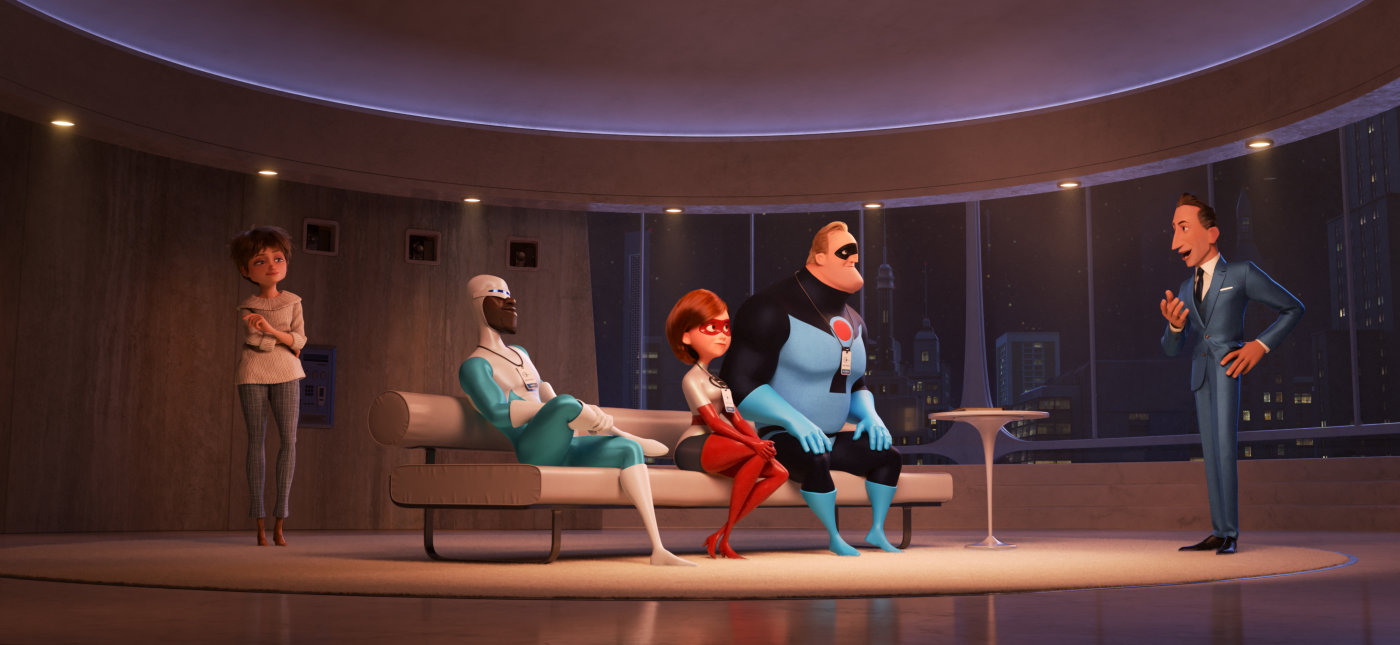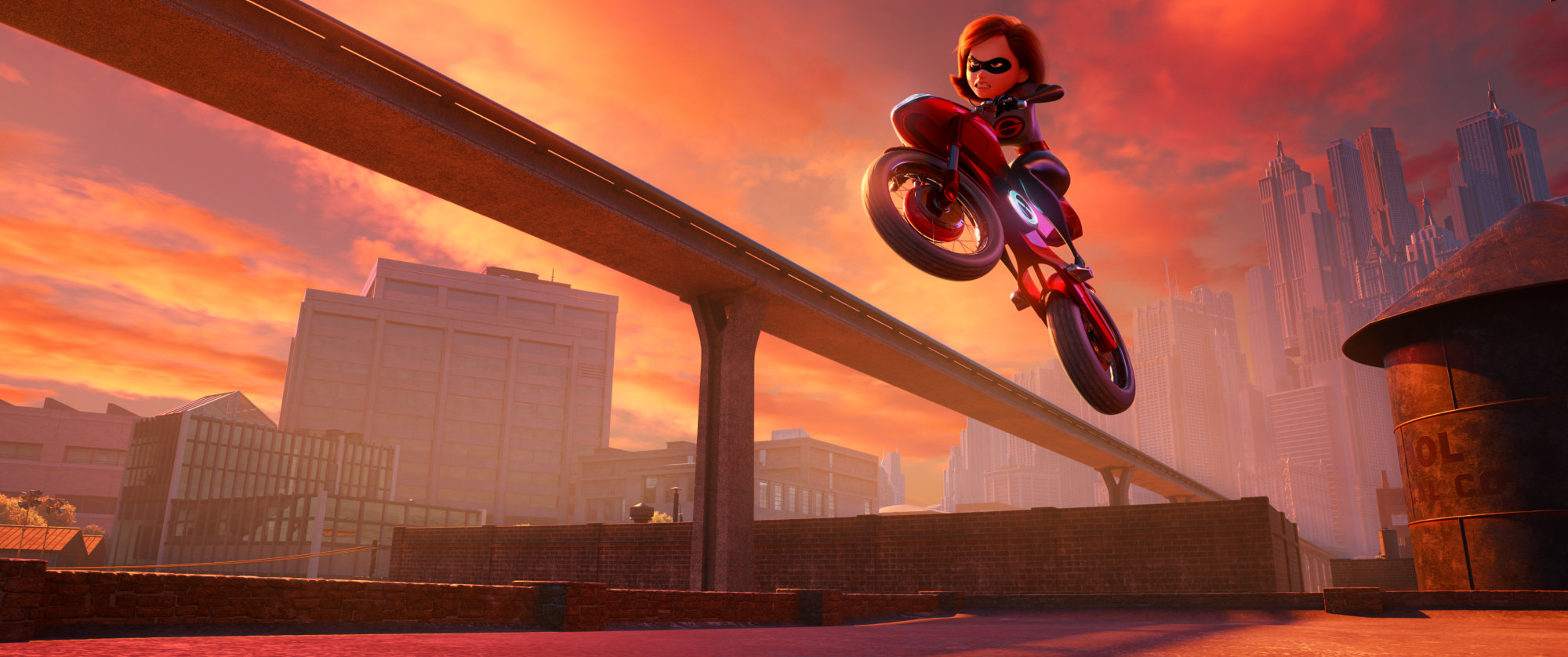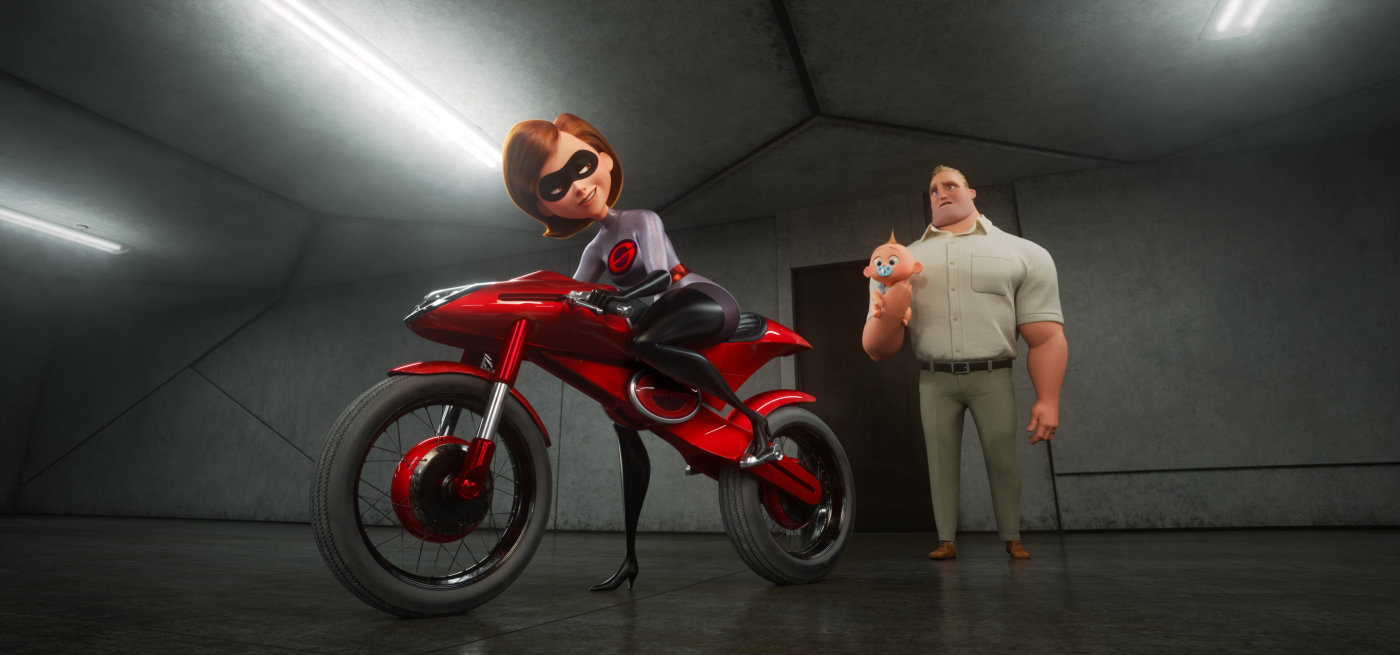Brad Bird interview: Incredibles 2, Mission: Impossible, critics
Brad Bird chats to us about returning The Incredibles, how critics react to his films, Mission: Impossible and more...
As the Parr family swing back into action to the strains of Michael Giacchino’s 60s-style score, it’s as though the supers have never been away.
Yet it’s already 14 years since the first Incredibles, and much has changed since, both within Pixar and without. Brad Bird has gone on to make such live-action movies as Mission: Impossible – Ghost Protocol and Tomorrowland; since The Incredibles became a box-office smash in 2004, the Marvel Cinematic Universe has seen superheroes take over the cultural zeitgeist.
Nevertheless, Incredibles 2 still has Bird’s same flair for eye-catching action – the kinds of set-pieces that move impossibly fast yet feel fluid and natural at the same time. We may be used to seeing superheroes swing across our screens these days, but Incredibles 2 still feels fun and fresh.
Behind the scenes, though, things were far less smooth: although Bird had the concept of Incredibles 2 in mind for a long time – that of Elastigirl striking out on her own terms while Mr Incredible becomes a stay-at-home parent – other elements were less easy to put together.
Deep into production, the villain was changed twice, according to producers Nicole Grindle and John Walker; as Bird admitted to us himself, an earlier concept, which involved artificial intelligence, simply became too complicated to make work in a brisk adventure movie. But as was the case with the first Incredibles, which had a villain change and dozens of its own technical challenges, the trials of production generated a hit movie – as we caught up with Bird in London, Incredibles 2 had already enjoyed a record-breaking weekend in the US.
With that worry off his shoulders, Brad Bird seemed relaxed and garrulous as we talked about a range of topics, from the villain change to action sequences, and his thoughts on the criticisms levelled at his movies. As you’ll see, he’s a candid chap…
You must be thrilled with the weekend [box-office] you’ve just had in the States.
That is a good thing, yes.
It must be a huge weight lifted. I can imagine, after years of hard work…
Yeah. Relief is the main emotion you feel. You get to make another one. You might get to make another film, so that’s always good news.
I know some directors really obsess over the finances of their films. How they did in this and that territory. Are you not like that?
Um, for me it’s a black hole that, if I pay too much attention to it, it takes some of the joy out of it. There are a million logical reasons to not make a film, and I think, if you get focused on all the critics, or money, or any of that other stuff, it never leads anywhere good. For me, I try as much as possible to just think about being in the movie theatre, having the lights dim, and what would I want to see on the screen. That puts me in the frame of mind that made me want to be in the movie business to begin with.
As long as I’m in that frame of mind, then I’m in a good frame of mind.

Right. I was talking to the producers earlier, and they were saying it was about three years in the making, this film. Give or take.
A little less than that.
So what was the point, then, where you knew you had the right idea to go ahead into full production? The trigger.
The core idea of the role switch between Bob and Helen. I had that 14 years ago when we were promoting the first film. Then I knew I had the unexploded bomb of Jack-Jack – the fact that the audience knew that he had multiple powers that the Parr family did not. I knew I had that. But the superhero aspect of it, the villain plot, was always changing. When I finally felt like I had the idea that made it all work, I pitched it, everyone went for it, it got a greenlight, it got a release date, we got producers, everybody started moving.
And I got about five months in and realised that idea wasn’t going to serve the core idea very well. So that villain story was always changing. It was kind of like the first film, where the villain was the last character that we had.
On the first film, we were in motion, I’d sold the idea, we had all the characters designed before I came to Pixar. It’s the only outside project that’s ever been brought into Pixar. But we had a different villain, and we got going with a different villain. Then I did an alternate opening where I introduced a villain that I then killed off, and everyone, including myself, liked that villain better than the one we were intending to have as our main guy. So that became Syndrome, and we created the backstory for him and all that.
I wasn’t aware until about a week ago, when I was talking to somebody like this, that I realised we didn’t have the right villain in our first movie either. It just happens to be a feature of making these movies – the villain that we started out with inevitably gets discarded, and a new villain comes in.
But the core of the story in the first movie is not about the villain. The core of this movie isn’t about the villain either – it’s about the family and what’s going on with them. Their reaction to the situations that are happening to them. That’s where we live. The superhero part is really a way to comment on the family.

I didn’t realise the villain had changed when I was watching it. When I saw it, I was thinking how well the villain fits with the 60s theme, because in the 60s and 70s there was that scare about mind control and subliminal messaging…
Sure, sure. And everyone’s watching too much television and all of that, sure.
Yeah. So why did that villain fit? Did you have several options you could have picked from?
No, like I said, I had a different idea that had to do with AI when we started doing this film. It still had the role-switch and all of that. But that ended up being too complicated, and the more we worked on it, the more complicated it seemed to get. It was interesting – it wasn’t a bad idea. It was a good idea. But it didn’t serve the part that I was committed to, which was the family stuff – the role-switch stuff, the Jack-Jack stuff, all of that was not served well by that storyline. So I started casting about: “Okay, what does the villain want, what’s the villain’s power.”
I came upon this Screenslaver idea. I thought, that’s a really good thing to have them hypnotise people, because they are everywhere. They can be on monitors and planes and trains. They can be in people’s homes. It’s a way for the villain to expand the reach. So it seemed serviceable.
The action’s terrific, as it always is in your films.
Thank you.

I wonder, though, whether you’ve learned certain things by moving between animation to live-action and back. Particularly on Mission: Impossible [Ghost Protocol].
Well, actually, it was more the other way around. When I made the first Incredibles, Tom Cruise really liked it and asked me to come over to his place. I came over and we talked very intensely about what films we liked and what we thought was underrated and all this stuff. He liked very much how the action scenes were staged, not only in [The Incredibles] but also The Iron Giant.
I was very touched and pleased that he didn’t see them as separate things. He saw it all as film. He didn’t go, “Well, you do animation fine, but you could never handle the big-boy leagues with people and actual things that you can touch”, you know? He didn’t see it that way at all. He said, you know what a good shot is, you know how to pace things, you know how to represent things in a clear manner, with adrenaline. He was excited.
He said, “Would you ever be interested in doing a live-action movie?” And I said, “Absolutely.”
And I had actually written for live-action movie before that, and I’d had live-action things get on the runway but not got cleared for take-off. So it’s not like it was as new to me as something that I’d studied and endeavoured to get those jobs. It’s just the opportunities came in animation and the same level of opportunities didn’t come in live-action.
I love them both, and they’re both film to me and they’re fine. But I loved that Tom didn’t see them as separate. Years later, when Mission came up, he actually had his stunt team study the action scenes in those movies. I did a couple of action sequences in Ratatouille, and the stunt guys are going, “Well, we’re looking at animation,” but Tom said, “Look at how the shots are composed.”
So it was actually a delight to enter the world of live-action filmmaking as something as wide-open as Mission: Impossible. Which means that it’s a series of films that embraces a lot of different directors’ styles rather than trying to make us all do them in one house style. Tom’s enthusiasm for working with me helped a lot. He protected me on that film in a really good way. He allowed me the elbow room to get things done the way I wanted to make them. He made a very difficult film doable, you know?

So your job as a director, other than the logistics of working with actors rather than animators, there’s not a huge difference in those disciplines.
No. I mean, I have storyboarded before that. I’ve storyboarded for things other people have shot. So thinking in shots and orchestrating shots is not foreign to me at all. And that goes whether you’re doing live action or animation. And I think it would’ve been a rougher transition if I’d gone from Iron Giant into live action, than going from Incredibles and Ratatouille. Because in CG animation, you’re mimicking real lenses. You can say, “Okay, I want a 24…”
They had their own lens system at Pixar that didn’t correspond to actual lenses. So I’d say, “I want a 20 here, so what would that be?” And they’d go, “That’s a 17.” I’d go, “What does that mean?” And they would stop and do the math in their head and go, “It’d be like a 24mm lens.”
I’d go, “Why didn’t you just say 24? Because I get that!” It’s like cameras in live-action or still cameras. “Why don’t you speak the universal language instead of having your own insular language?” But, you know, it was very separately.
But with [virtual] cameras, you can mimic the lenses from live-action perfectly, and they distort exactly the way they would [in reality]. So moving a camera in space became much more smooth for me to think about, going from CG to something like Mission: Impossible.
I guess in CG, you’re thinking about where the characters are in a 3D space, establishing the geography of that, is so important.
Yeah, and it’s more akin to real perspective. You can do cheats better in hand-drawn animation. With CG, it wants you to obey physical laws – it doesn’t mean you have to, but the machine’s default is to obey real space and physics and how it’s used.

I remember seeing the extras on the first Incredibles, and how that film pushed the technical envelope. So what were you pushing this time, do you think, and was it as difficult technically to pull off?
Well, no. On the first film, we were basically doing everything that CG was then bad at. It was bad at humans, it was bad at hair, it was bad at fabric and fire and water – and that’s all our film was. So we were on the edge of failure the entire time we were making the film, and it’s amazing that we got out of there and got everything to work as well as we did.
It was all extremely cutting edge at the time. I think we kind of changed how people did humans in CG animation after. If you look at films before Incredibles, they tended to be photorealistic in a clunky and ugly way, with pores in their skin and too many eyelashes. It’s kind of disturbing. And since, the designs have gotten a lot more playful in a lot of people’s films, not just ours.
In this film, everything’s advanced enough to a point where not only is it doable, but it’s actually the characters even look subtly – to everyone except us – closer to how we originally intended them to look. We just couldn’t quite get it.
So we turned to our original hand sculpts of the characters as a starting place on this one. We were able to get them exactly how we originally designed them. The controls are more sophisticated on their faces, so if our animators are drivers, we’ve given them far better cars to drive. They still have to drive, and drive well, but they have much better rigs. They can express things much more precisely and in an aesthetically appealing way.

I always find it interesting reading about all the different things people read into your films, politically. Even if I don’t necessarily agree with them. I wonder if you feel the same way. There were some quite bizarre things written about Incredibles and Tomorrowland and objectivism – that kind of thing.
Well, yeah. At some point I just have to give up, you know? Yeah, sure. After Iron Giant, I was the big lefty who was trying to apologise or make Russia seem like it was friendly to some very misguided reviewers. I was being soft on Communism or something.
Then I became the right-wing darling with Incredibles, where it was seen as being elitist, which I thought was a misread of The Incredibles. But I had to sort of go [wearily], “Okay”.
Then of course I was a lefty again with my food-loving, French-hugging Ratatouille. I find it really kind of tedious, a lot of it. Poorly thought out.
Then someone from the Atlantic did an article and finally kind of – I thought – expressed what I’ve been to express, and seeing a unity in the films that I thought was much better.
There’s a lazy Ayn Rand thing that some people picked up on. I’ve read Ayn Rand, and I think young people, particularly when you’re in your early 20s and it’s you against the world, you should absolutely believe in that very, almost strident individualism. But I think, when you become a little older, you see the limits of that; compromise is not a terrible thing always.
There’s bad compromise, but there’s good compromise. And there’s not a lot of humour in Ayn Rand, you know? You kind of go, “Come on Ayn, lighten up a little!”
Me being the Ayn Rand guy is a lazy piece of criticism. And if I did filmmaking that was as lazy as that analysis, it would all be shit. So let’s get that straight up right now. There are shitty critics out there, just like there are shitty filmmakers.
And a lot of them… you can’t get too absorbed in them. You just have to say, “What is the story I want to tell?” and tell it as well as you can.
Great answer. Brad Bird, thank you very much.